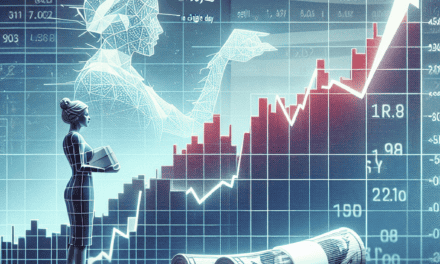“Market Shakes: Dow Dips on Buffett’s Caution, Trump Stock Rockets 204% in Dramatic Rebound”
Introduction
The stock market experienced significant turbulence as the Dow Jones Industrial Average took a sharp dive following a cautionary statement from renowned investor Warren Buffett. This downturn comes amidst a backdrop of economic uncertainty and investor apprehension. In contrast, stocks associated with former President Donald Trump saw a remarkable surge, skyrocketing by 204% and rebounding to a critical level. This live update delves into the factors influencing these dramatic market movements, examining the implications of Buffett’s warning and the unexpected rally in Trump-linked stocks.
Impact Of Buffett’s Warning On The Dow Jones
The stock market experienced a tumultuous day as the Dow Jones Industrial Average plummeted following a stark warning from renowned investor Warren Buffett. His cautionary remarks about potential overvaluation in certain sectors sent ripples through the market, causing investors to reassess their positions. Buffett, often regarded as a bellwether for market sentiment, expressed concerns over the sustainability of current stock prices, particularly in the technology and consumer discretionary sectors. This prompted a wave of selling, leading to a significant drop in the Dow Jones, which closed the day with a notable decline.
In contrast, amidst the broader market downturn, shares of companies associated with former President Donald Trump experienced a remarkable surge. One such stock skyrocketed by an astonishing 204%, rebounding to a key level that caught the attention of investors and analysts alike. This dramatic increase was fueled by renewed interest in Trump’s business ventures and speculation about potential future developments. The surge in Trump’s stock provided a counterbalance to the overall market decline, highlighting the divergent paths of different sectors and individual stocks.
The impact of Buffett’s warning was not limited to the Dow Jones alone. It reverberated across global markets, with investors worldwide taking heed of his advice. As a result, European and Asian markets also experienced declines, albeit to varying degrees. This global reaction underscores the influence that prominent figures like Buffett wield over investor sentiment and market dynamics. His words serve as a reminder of the interconnectedness of global financial markets and the speed at which information can impact investor behavior.
While the Dow Jones faced downward pressure, the surge in Trump’s stock demonstrated the resilience and unpredictability of certain market segments. This divergence highlights the importance of diversification in investment portfolios, as different sectors and stocks can react differently to market stimuli. Investors are reminded of the need to balance risk and reward, taking into account both macroeconomic factors and individual company performance.
Moreover, the day’s events underscore the importance of staying informed and adaptable in the ever-changing landscape of the stock market. As new information emerges and market conditions evolve, investors must be prepared to adjust their strategies accordingly. This includes paying attention to influential voices like Buffett, whose insights can provide valuable guidance in navigating complex market environments.
In conclusion, the stock market’s reaction to Buffett’s warning and the subsequent surge in Trump’s stock illustrate the dynamic nature of financial markets. While the Dow Jones experienced a significant decline, the rise in Trump’s stock served as a reminder of the potential for unexpected opportunities. Investors are encouraged to remain vigilant, continuously assess their portfolios, and consider a diverse range of factors when making investment decisions. As the market continues to evolve, staying informed and adaptable will be key to successfully navigating the challenges and opportunities that lie ahead.
Analysis Of Trump’s Stock Surge And Rebound
In recent developments within the stock market, significant fluctuations have captured the attention of investors and analysts alike. The Dow Jones Industrial Average experienced a notable decline following a cautionary statement from renowned investor Warren Buffett. Meanwhile, a particular stock associated with former President Donald Trump has demonstrated an extraordinary surge, rebounding to a critical level. This juxtaposition of market movements underscores the complex dynamics at play in today’s financial landscape.
To begin with, the Dow Jones’ downturn can be attributed to Buffett’s warning, which resonated deeply with market participants. His insights, often regarded as a barometer for economic sentiment, have historically influenced investor behavior. Buffett’s cautionary remarks likely prompted a reevaluation of risk, leading to a sell-off in the Dow Jones. This reaction highlights the sensitivity of the market to influential voices and the broader implications of investor sentiment on market stability.
Conversely, the remarkable ascent of Trump’s stock, which surged by an impressive 204%, presents a fascinating case study in market psychology and investor behavior. This surge can be attributed to a confluence of factors, including renewed interest in Trump’s business ventures and the potential for future growth. The stock’s rebound to a key level suggests a restoration of investor confidence, possibly driven by strategic announcements or favorable market conditions. This phenomenon illustrates the power of narrative and perception in shaping market outcomes, as investors often respond to both tangible developments and speculative prospects.
Furthermore, the contrasting movements of the Dow Jones and Trump’s stock underscore the diverse nature of market forces. While the Dow’s decline reflects broader economic concerns and cautionary sentiment, the surge in Trump’s stock highlights the potential for individual equities to defy broader market trends. This divergence serves as a reminder of the multifaceted nature of the stock market, where various factors can simultaneously influence different segments.
In addition, the current market environment is characterized by heightened volatility, as evidenced by these recent developments. Investors are navigating a landscape marked by uncertainty, where geopolitical tensions, economic indicators, and corporate earnings reports all play pivotal roles. The interplay between these elements creates a dynamic environment where rapid shifts in sentiment can lead to significant market movements. As such, investors must remain vigilant and adaptable, employing strategies that account for both short-term fluctuations and long-term trends.
Moreover, the implications of these market movements extend beyond immediate financial outcomes. They offer insights into broader economic trends and investor priorities. For instance, the response to Buffett’s warning may signal growing concerns about economic stability, while the enthusiasm for Trump’s stock could reflect a renewed focus on growth-oriented investments. These trends provide valuable context for understanding the evolving landscape of the stock market and the factors that drive investor decision-making.
In conclusion, the recent fluctuations in the stock market, exemplified by the Dow Jones’ decline and Trump’s stock surge, highlight the intricate interplay of market forces and investor sentiment. As investors navigate this complex environment, they must remain attuned to both macroeconomic indicators and individual stock dynamics. By understanding the underlying factors driving these movements, investors can better position themselves to capitalize on opportunities and mitigate risks in an ever-changing market landscape.
Key Factors Behind The Dow Jones Plummet
The recent downturn in the Dow Jones Industrial Average has captured the attention of investors and analysts alike, as the index experienced a significant drop following a cautionary statement from renowned investor Warren Buffett. This decline has raised concerns about the broader market’s stability and the potential implications for the global economy. Buffett, known for his prudent investment strategies and insightful market predictions, issued a warning about overvalued stocks and the potential for a market correction. His remarks, delivered during a high-profile financial conference, underscored the risks associated with the current economic environment, characterized by rising interest rates and geopolitical tensions.
Buffett’s warning resonated with investors, prompting a wave of selling that contributed to the Dow’s sharp decline. The market’s reaction highlights the influence of Buffett’s opinions on investor sentiment, as his track record lends significant weight to his assessments. Moreover, his comments come at a time when the market is already grappling with uncertainty, including concerns about inflationary pressures and the Federal Reserve’s monetary policy stance. As a result, investors are increasingly cautious, seeking to mitigate risks by reallocating their portfolios and reducing exposure to equities.
In contrast to the Dow’s decline, shares of companies associated with former President Donald Trump experienced a remarkable surge, with one particular stock rebounding by 204%. This dramatic increase can be attributed to a combination of factors, including renewed investor interest and strategic business developments. The stock’s resurgence to a key level has been fueled by speculation about potential ventures and partnerships that could enhance the company’s growth prospects. Additionally, the stock’s performance has been bolstered by a wave of retail investor enthusiasm, reminiscent of previous market phenomena driven by social media platforms and online trading communities.
The juxtaposition of the Dow’s decline and the Trump stock’s surge underscores the complexity of the current market landscape. While traditional market indicators signal caution, certain segments of the market continue to exhibit volatility and speculative behavior. This divergence reflects the broader challenges facing investors as they navigate an environment marked by both opportunity and risk. The contrasting movements also highlight the importance of diversification and strategic asset allocation in managing investment portfolios.
As the market continues to react to these developments, investors are closely monitoring economic indicators and corporate earnings reports for further insights into the market’s trajectory. The interplay between macroeconomic factors and company-specific news will likely shape market dynamics in the coming weeks. Furthermore, the ongoing geopolitical tensions and their potential impact on global trade and economic growth remain key considerations for market participants.
In conclusion, the recent fluctuations in the Dow Jones Industrial Average and the surge in Trump-related stocks illustrate the multifaceted nature of today’s financial markets. While Buffett’s warning has prompted caution among investors, the unexpected rise in certain stocks highlights the potential for rapid shifts in market sentiment. As investors seek to navigate this complex environment, a balanced approach that considers both macroeconomic trends and individual company performance will be essential in making informed investment decisions. The coming months will undoubtedly present both challenges and opportunities, as market participants adapt to an evolving economic landscape.
Market Reactions To Buffett’s Economic Outlook

In the ever-volatile world of stock markets, recent developments have captured the attention of investors and analysts alike. The Dow Jones Industrial Average experienced a significant downturn following a stark warning from renowned investor Warren Buffett. His cautionary remarks about the potential for economic turbulence sent ripples through the market, causing investors to reassess their positions. Buffett, often referred to as the “Oracle of Omaha,” has a reputation for his astute market insights, and his words carry considerable weight. Consequently, his warning prompted a wave of selling, leading to a notable decline in the Dow Jones.
As investors digested Buffett’s outlook, the market’s reaction was swift and pronounced. The Dow Jones, a key barometer of the U.S. stock market’s health, saw a sharp drop, reflecting the heightened anxiety among market participants. This decline underscores the sensitivity of the market to influential voices and the broader economic context. While some investors may view such downturns as opportunities to buy undervalued stocks, others may adopt a more cautious approach, opting to wait for further clarity on economic conditions.
In contrast to the Dow’s decline, another intriguing development unfolded in the market. Shares of a company associated with former President Donald Trump experienced a remarkable surge, soaring by 204%. This dramatic rebound to a key level caught the attention of traders and analysts, sparking discussions about the factors driving this unexpected rally. The surge in Trump’s stock can be attributed to a confluence of factors, including renewed investor interest and speculation about the company’s future prospects. Such movements highlight the dynamic nature of the stock market, where individual stocks can experience significant fluctuations based on a variety of influences.
The juxtaposition of these two market events—the Dow’s decline and Trump’s stock surge—illustrates the complexity and unpredictability inherent in financial markets. While Buffett’s warning served as a sobering reminder of potential economic challenges, the rally in Trump’s stock demonstrated the market’s capacity for unexpected turns. This duality is a testament to the diverse factors that can influence market behavior, from macroeconomic indicators to individual company developments.
As investors navigate these turbulent waters, it is crucial to maintain a balanced perspective. While short-term market movements can be unsettling, they often reflect broader economic trends and investor sentiment. In times of uncertainty, diversification and a long-term investment strategy can help mitigate risks and capitalize on potential opportunities. Moreover, staying informed about market developments and expert opinions can provide valuable insights for making informed investment decisions.
In conclusion, the recent market reactions to Buffett’s economic outlook and the surge in Trump’s stock underscore the dynamic and multifaceted nature of financial markets. As the Dow Jones grapples with the implications of Buffett’s warning, investors are reminded of the importance of vigilance and adaptability in navigating market fluctuations. Meanwhile, the unexpected rally in Trump’s stock serves as a reminder of the market’s potential for surprising turns. As always, investors are encouraged to approach the market with a well-considered strategy, balancing caution with the pursuit of opportunities in an ever-changing landscape.
Understanding The 204% Surge In Trump Stock
In recent developments within the stock market, a significant shift has captured the attention of investors and analysts alike. The Dow Jones Industrial Average experienced a notable decline following a cautionary statement from renowned investor Warren Buffett. Meanwhile, a remarkable surge was observed in the stock associated with former President Donald Trump, which skyrocketed by 204%, rebounding to a critical level. This unexpected movement in Trump-related stock has prompted a closer examination of the factors contributing to such a dramatic increase.
To understand the 204% surge in Trump stock, it is essential to consider the broader context of market dynamics and investor sentiment. The stock market is inherently influenced by a myriad of factors, including political developments, economic indicators, and public perception. In this instance, the surge can be attributed to a combination of speculative trading, strategic announcements, and the influence of social media platforms that amplify investor interest and engagement.
One of the primary drivers behind the surge is the announcement of a new business venture or strategic partnership involving Trump or his associated entities. Such announcements often generate significant media coverage and public interest, leading to heightened investor activity. In this case, the anticipation of potential financial gains from the venture likely fueled speculative trading, as investors sought to capitalize on the perceived opportunity.
Moreover, the role of social media cannot be underestimated in this context. Platforms like Twitter and Reddit have become powerful tools for disseminating information and rallying investor support. The rapid spread of news and opinions through these channels can create a sense of urgency and excitement, prompting a surge in trading volume and stock prices. In the case of Trump stock, social media discussions and endorsements may have played a pivotal role in driving the stock’s meteoric rise.
Additionally, it is important to consider the psychological aspect of investing, particularly in stocks associated with high-profile figures like Donald Trump. The former president’s polarizing persona and continued influence in political and business circles can evoke strong emotional responses from investors. This emotional engagement can lead to increased buying activity, as supporters rally behind the stock, while detractors may engage in short-selling or other strategies to capitalize on perceived volatility.
Furthermore, the broader market environment also plays a crucial role in shaping investor behavior. In times of economic uncertainty or market volatility, investors often seek alternative opportunities that promise higher returns. The allure of a stock associated with a prominent figure like Trump, coupled with the potential for substantial gains, can attract risk-tolerant investors looking to diversify their portfolios.
In conclusion, the 204% surge in Trump stock is a multifaceted phenomenon driven by a combination of strategic announcements, social media influence, and investor psychology. While the stock market is inherently unpredictable, understanding the underlying factors contributing to such dramatic movements can provide valuable insights for investors and analysts. As the market continues to evolve, it remains essential for stakeholders to stay informed and adapt to the ever-changing landscape, ensuring that they are well-positioned to navigate future opportunities and challenges.
Historical Context Of Dow Jones Fluctuations
The Dow Jones Industrial Average, a key barometer of the U.S. stock market’s health, has experienced numerous fluctuations throughout its storied history. These fluctuations often reflect broader economic trends, investor sentiment, and geopolitical events. Understanding the historical context of these movements can provide valuable insights into the current market dynamics, particularly in light of recent developments.
The Dow Jones, established in 1896, has weathered many economic storms, including the Great Depression, the dot-com bubble, and the 2008 financial crisis. Each of these events left an indelible mark on the index, shaping investor behavior and market strategies. For instance, the Great Depression of the 1930s saw the Dow plummet by nearly 90%, a stark reminder of the market’s vulnerability to economic downturns. Similarly, the 2008 financial crisis resulted in a significant drop, with the index losing over 50% of its value at its lowest point. These historical downturns underscore the importance of understanding market cycles and the factors that drive them.
In recent times, the Dow Jones has been influenced by a myriad of factors, including corporate earnings reports, Federal Reserve policies, and global trade tensions. However, the market’s reaction to influential figures and their statements cannot be underestimated. A recent example is the sharp decline in the Dow following a warning from Warren Buffett, one of the most respected investors in the world. Buffett’s cautionary remarks about potential overvaluation in certain sectors prompted a wave of selling, as investors reassessed their positions in light of his insights. This reaction highlights the significant impact that influential voices can have on market sentiment and investor behavior.
Conversely, while the Dow faced downward pressure, certain stocks have demonstrated remarkable resilience and growth. Notably, shares associated with former President Donald Trump experienced a dramatic surge, climbing 204% and rebounding to a key level. This surge can be attributed to a combination of factors, including renewed investor interest and strategic business developments. The stark contrast between the broader market’s decline and the rise of Trump-related stocks illustrates the diverse nature of market movements and the potential for individual stocks to defy broader trends.
The juxtaposition of these events serves as a reminder of the complex interplay between macroeconomic factors and individual stock performance. While the Dow Jones provides a snapshot of the overall market, it is essential to consider the underlying components and their unique trajectories. Investors must remain vigilant, continuously analyzing both historical patterns and current developments to make informed decisions.
In conclusion, the historical context of Dow Jones fluctuations offers valuable lessons for navigating the current market landscape. By examining past events and understanding the factors that drive market movements, investors can better anticipate potential challenges and opportunities. As the market continues to evolve, staying informed and adaptable will be crucial for achieving long-term success. The recent developments, including Buffett’s warning and the surge in Trump-related stocks, underscore the dynamic nature of the stock market and the importance of maintaining a balanced perspective amidst volatility.
Investor Strategies Amidst Market Volatility
In the ever-fluctuating world of finance, investors are constantly seeking strategies to navigate the unpredictable tides of the stock market. Recent developments have once again underscored the importance of adaptability and informed decision-making. The Dow Jones Industrial Average recently experienced a significant downturn following a cautionary statement from renowned investor Warren Buffett. His warning about potential overvaluations in certain sectors sent ripples through the market, prompting investors to reassess their portfolios and strategies. As the Dow Jones plummeted, it became evident that even the most seasoned investors must remain vigilant and responsive to market signals.
In stark contrast to the Dow’s decline, shares of a company associated with former President Donald Trump surged by an astonishing 204%, rebounding to a key level that caught the attention of market participants. This dramatic rise serves as a reminder of the market’s inherent volatility and the potential for unexpected opportunities. For investors, such fluctuations present both challenges and prospects, necessitating a balanced approach that considers both risk and reward.
Amidst this backdrop of market turbulence, investors are increasingly turning to diversified strategies to mitigate risk. Diversification, a time-tested approach, involves spreading investments across various asset classes to reduce exposure to any single market segment. By doing so, investors can potentially cushion their portfolios against sudden market swings, such as those witnessed in the Dow Jones and Trump-associated stocks. Moreover, diversification allows investors to capitalize on growth opportunities in different sectors, thereby enhancing the potential for long-term gains.
In addition to diversification, investors are also focusing on fundamental analysis to guide their decisions. This approach involves evaluating a company’s financial health, management quality, and market position to determine its intrinsic value. By grounding investment choices in solid research and analysis, investors can make informed decisions that align with their financial goals and risk tolerance. In times of market volatility, such as the current environment, a strong foundation in fundamental analysis can provide a sense of stability and confidence.
Furthermore, the recent market movements have highlighted the importance of staying informed about macroeconomic trends and geopolitical developments. Factors such as interest rate changes, inflationary pressures, and international trade dynamics can significantly impact market performance. By keeping abreast of these broader influences, investors can better anticipate potential market shifts and adjust their strategies accordingly. This proactive approach enables investors to remain agile and responsive, even in the face of uncertainty.
As the stock market continues to navigate through these turbulent times, it is crucial for investors to maintain a long-term perspective. While short-term fluctuations can be unsettling, history has shown that markets tend to recover and grow over time. By focusing on long-term objectives and maintaining a disciplined approach, investors can weather the storms of volatility and position themselves for future success.
In conclusion, the recent developments in the stock market serve as a poignant reminder of the importance of strategic planning and adaptability. Whether it is responding to warnings from influential figures like Warren Buffett or capitalizing on unexpected opportunities, investors must remain vigilant and informed. By employing diversified strategies, conducting thorough fundamental analysis, and staying attuned to macroeconomic trends, investors can navigate the complexities of the market with confidence and resilience.
Q&A
1. **What caused the Dow Jones to plummet?**
– The Dow Jones plummeted following a warning from Warren Buffett about potential economic challenges or market overvaluation.
2. **What was Warren Buffett’s warning about?**
– Warren Buffett warned about potential economic challenges or the possibility of the stock market being overvalued, which led to investor concerns.
3. **How did Trump’s stock perform?**
– Trump’s stock surged by 204%, indicating a significant rebound to a key level.
4. **What factors contributed to the surge in Trump’s stock?**
– The surge in Trump’s stock could be attributed to positive news, investor sentiment, or developments related to his business ventures.
5. **What is the significance of the key level Trump’s stock rebounded to?**
– The key level signifies a critical price point or resistance level that the stock managed to surpass, indicating potential bullish momentum.
6. **How did the broader stock market react to these events?**
– The broader stock market experienced volatility, with the Dow Jones plummeting while certain individual stocks, like Trump’s, saw significant gains.
7. **What should investors consider in light of these developments?**
– Investors should consider the implications of Buffett’s warning, assess market conditions, and evaluate individual stock performance and potential risks.
Conclusion
The stock market experienced significant volatility, with the Dow Jones Industrial Average dropping sharply following a warning from Warren Buffett, a highly influential investor. This decline indicates investor concern and potential market instability. In contrast, stocks associated with former President Donald Trump saw a remarkable surge of 204%, rebounding to a critical level. This suggests strong investor interest or speculation in Trump-related ventures, possibly driven by political developments or market sentiment. Overall, the contrasting movements highlight the market’s sensitivity to influential figures and the potential for rapid shifts based on news and investor perceptions.





